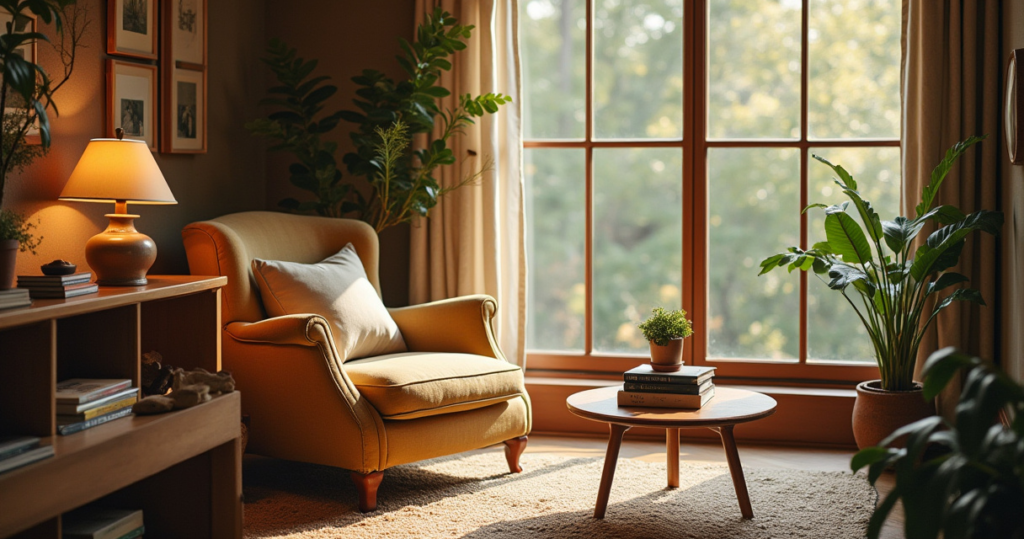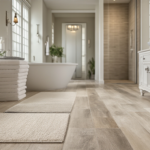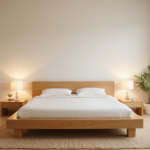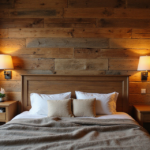Your living room deserves lighting that does more than simply illuminate—it should create atmosphere, support your daily rituals, and celebrate the bold design choices that make your space uniquely yours. Yet too many beautiful rooms fall flat under the harsh glare of a single overhead fixture or struggle with poorly placed lamps that create more shadows than solutions. The magic happens when you layer light like you layer patterns and textures, building depth and visual intrigue that makes every corner of your room come alive.
Think beyond basic functionality and embrace lighting as the ultimate design tool for maximalist spaces. Whether you’re highlighting a gallery wall of collected treasures, creating intimate reading nooks among your abundant furnishings, or orchestrating dramatic evening scenes for entertaining, masterful living room light design transforms ordinary spaces into curated environments that tell your story. The key lies in understanding how different types of light work together—ambient foundations, focused task lighting, and accent illumination that makes your collections shine.
Ready to unlock the full potential of your most important gathering space? These 22 brilliant strategies will guide you through creating a lighting scheme as bold and layered as your design aesthetic, ensuring every treasured object, rich texture, and vibrant color gets the attention it deserves.
1. Assess Your Room’s Function and Desired Atmosphere
Before diving into fixture catalogs or browsing online galleries, take time to understand how your living room actually lives and breathes throughout the day. Your living room light strategy should support the specific activities that happen in your space—from morning coffee rituals to late-night creative sessions—while creating the emotional atmosphere that reflects your personality. This foundational assessment prevents the common mistake of choosing fixtures based purely on aesthetics without considering their practical purpose.
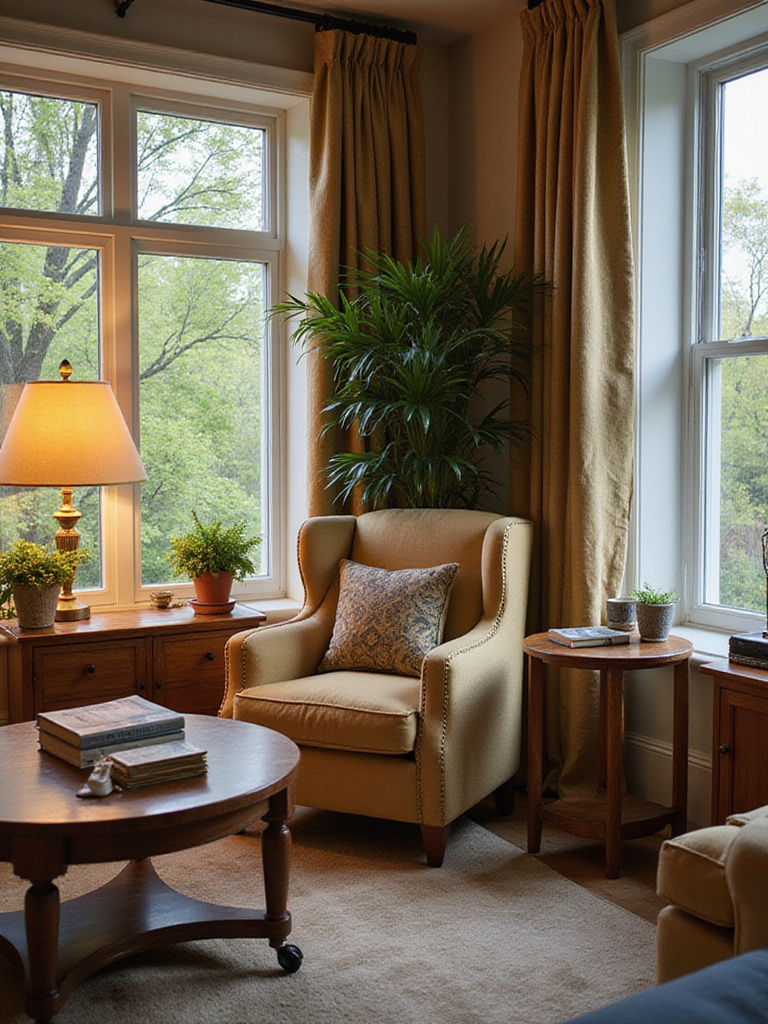
Document your room’s daily rhythms and identify the zones where different activities occur. Do you curl up in a specific corner with art books? Mark that spot for focused task lighting. Is your coffee table the center of puzzle-building marathons? Plan for adjustable illumination there. Consider how your abundant collections and layered furnishings interact with light throughout the day, noting which pieces catch natural light beautifully and which disappear into shadows.
- Morning activities: Note where you read newspapers, check devices, or enjoy coffee
- Evening entertainment: Identify conversation areas and spaces for hosting guests
- Creative pursuits: Mark zones for crafting, reading, or working on collections
- Relaxation rituals: Observe where you unwind and need softer, more intimate lighting
The designer’s secret here is to create a simple floor plan sketch marking these activity zones alongside your desired emotional responses—energizing, contemplative, dramatic, or cozy. This becomes your lighting roadmap, ensuring every fixture choice serves both function and feeling in your maximalist haven.
2. Master the Essential Three-Layer Lighting Foundation
Creating sophisticated living room light requires understanding the fundamental principle that transforms ordinary rooms into extraordinary spaces: layering. Just as you layer patterns, textures, and colors to create visual richness, you must layer different types of illumination to achieve both functionality and drama. This approach moves far beyond the single overhead fixture that flattens your carefully curated collections and robs your space of dimensional beauty.

The first layer, ambient lighting, provides your foundational glow—think of it as the canvas upon which you’ll paint with light. This general illumination ensures comfortable navigation and prevents harsh shadows that can make even the most beautiful rooms feel unwelcoming. The second layer, task lighting, delivers focused brightness exactly where you need it for specific activities like reading vintage design magazines or examining the details in your art collection. The final layer, accent lighting, creates the drama and visual hierarchy that makes your treasured objects sing.
- Ambient layer: Recessed lights, chandeliers, or large floor lamps providing overall brightness
- Task layer: Reading lamps, desk lights, or adjustable fixtures for specific activities
- Accent layer: Picture lights, uplights, or spotlights highlighting collections and architectural features
What makes this design special is the way each layer can function independently or work in harmony with the others. During a dinner party, you might use primarily ambient and accent lighting to create warmth and highlight your art collection, while morning reading sessions call for bright task lighting supplemented by gentle ambient glow.
3. Build Your Ambient Foundation for Maximum Comfort
The ambient layer serves as the backbone of your living room light design, providing the essential base illumination that makes your space feel welcoming and comfortable. This foundational layer prevents the harsh contrasts between bright spots and dark corners that can make even the most thoughtfully decorated rooms feel unbalanced. Think of ambient lighting as the gentle wash of illumination that allows your eyes to relax while showcasing the overall composition of your maximalist haven.
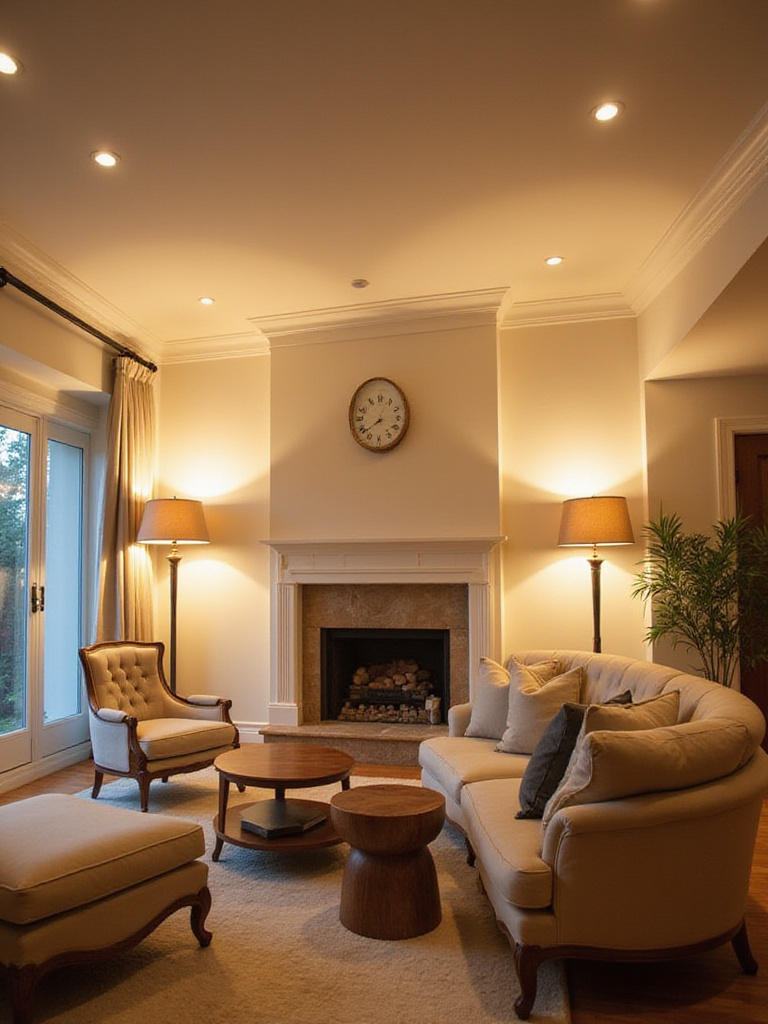
Proper ambient lighting makes your room feel larger and more cohesive by washing walls and ceilings with gentle illumination. This is particularly crucial in maximalist spaces where abundant furnishings and collections can create visual complexity—the right ambient foundation helps unify all these elements into a harmonious whole. Choose fixtures that distribute light broadly rather than creating focused pools, and opt for warm color temperatures (2700K-3000K) that enhance the cozy, collected atmosphere you’ve worked to create.
- Recessed lighting: Evenly spaced fixtures provide clean, unobtrusive general illumination
- Statement chandeliers: Large fixtures that complement your bold aesthetic while washing the room with light
- Torchiere floor lamps: Uplighting that bounces off ceilings for soft, diffused ambient glow
The magic of this piece lies in its ability to adapt throughout the day. Install dimmers on all ambient circuits to seamlessly transition from bright daytime illumination that energizes your space to softer evening light that creates intimacy among your collections. This flexibility transforms a single lighting system into multiple atmospheric experiences.
4. Identify Strategic Spots for Focused Task Lighting
Even in the most beautifully lit room, you need dedicated task lighting to support the activities that make your living room truly livable. Living room light becomes truly functional when you pinpoint the exact locations where focused illumination eliminates eye strain and enhances comfort during specific activities. This targeted approach ensures you can fully enjoy your space for reading, crafting, working with collections, or any detailed tasks that require clear, bright light.

Survey your room with fresh eyes, noting where you actually sit to read design books, sort through vintage finds, or work on creative projects. These activity zones require significantly more light than your ambient layer provides—typically 2-3 times brighter than general room illumination. Poor task lighting not only causes eye strain but can also prevent you from fully appreciating the details in your beloved books, artwork, or collection pieces.
- Reading chairs: Position adjustable floor lamps or swing-arm wall sconces to direct light onto pages
- Coffee tables: Use table lamps with focused downlight for puzzles, games, or close work
- Desk areas: Ensure adequate illumination for correspondence, planning, or digital work
The styling mistake most people make is placing task lights too far from the actual work surface or choosing fixtures that create shadows rather than eliminating them. Position your light source slightly behind and to the side of your dominant hand to minimize shadows on your work surface while avoiding glare in your eyes.
5. Use Accent Lighting to Celebrate Your Collections
This is where your living room light design becomes truly personal—accent lighting transforms your cherished collections, artwork, and architectural details into starring players in your room’s visual narrative. Rather than letting these treasures fade into the background, strategic accent lighting creates focal points that guide the eye and celebrate the objects that make your space uniquely yours. This layer adds the drama and sophistication that elevates a well-furnished room into a curated environment.
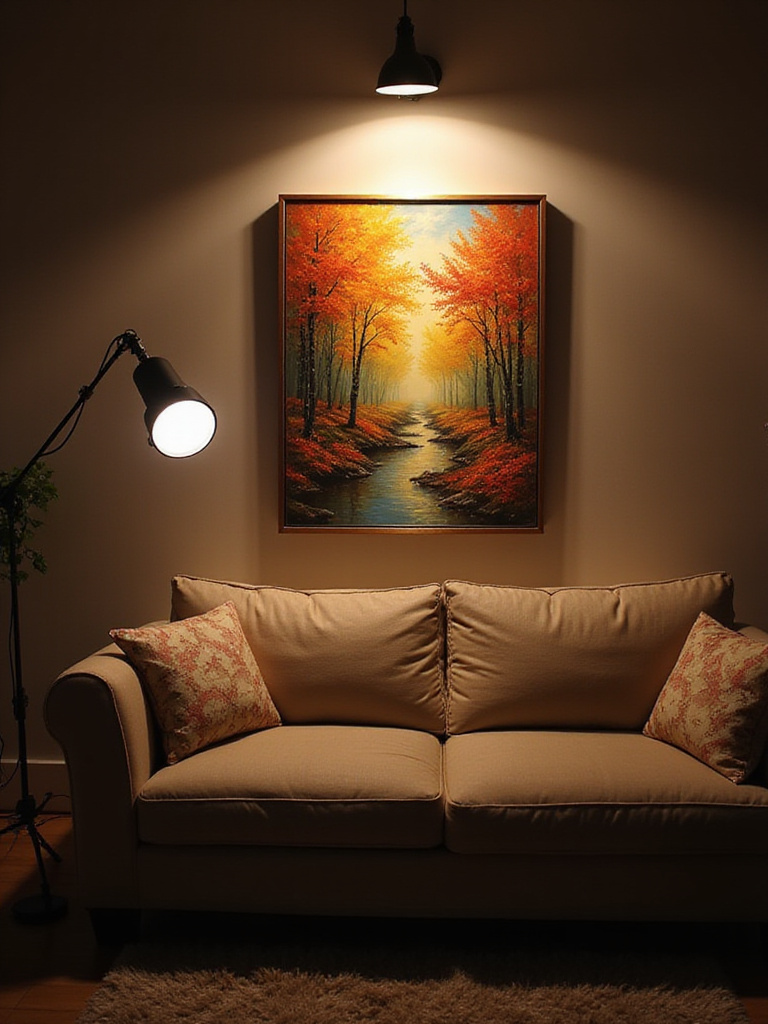
Accent lighting works by creating contrast—highlighting specific objects or areas while allowing others to recede into gentle shadow. This technique prevents the visual chaos that can occur in richly furnished spaces by establishing clear hierarchies of importance. Use narrow-beam fixtures to spotlight individual art pieces, uplights to dramatize architectural features, or picture lights to make your gallery walls come alive with depth and dimension.
- Picture lighting: Dedicated fixtures that make artwork colors vibrant and textures visible
- Display lighting: Small spotlights or LED strips that illuminate shelving and collected objects
- Architectural highlighting: Uplights or wall washers that emphasize columns, textures, or built-ins
The unexpected pairing that always works is combining accent lighting with dimmers—this allows you to adjust the intensity based on the time of day and the mood you want to create. During intimate gatherings, subtle accent lighting can make your collections feel mysterious and sophisticated, while brighter settings showcase every detail for guests who want to examine your treasures closely.
6. Select Overhead Fixtures That Command Attention
In maximalist spaces, your overhead fixture often serves as both primary light source and statement piece, making the selection of size and style crucial for achieving the right balance of function and visual impact. Your living room light centerpiece should complement your bold aesthetic while providing effective ambient illumination that doesn’t compete with your other design elements. The key lies in choosing fixtures that feel intentional and proportionate to your room’s scale and energy level.
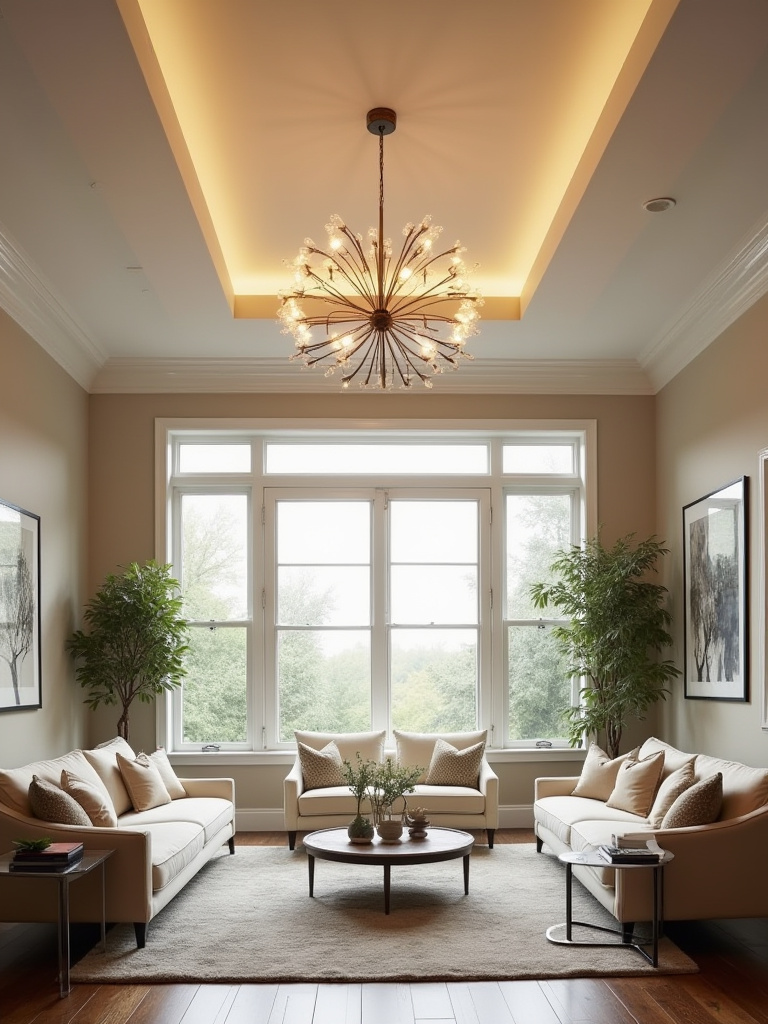
Scale becomes even more critical in richly furnished rooms where the overhead fixture must hold its own among abundant patterns, textures, and collections. A fixture that’s too small disappears into the visual complexity, while one that’s oversized can overwhelm even the most confident design scheme. Consider how the fixture’s style relates to your overall aesthetic—whether it echoes the curves in your furniture, picks up metallic finishes from your accessories, or provides a striking contrast that adds another layer of visual interest.
- Chandeliers: Choose designs with enough presence to anchor your room’s abundant style
- Pendant clusters: Group multiple fixtures for added visual weight and customizable light distribution
- Statement flush mounts: Ceiling-hugging designs that provide drama without overwhelming lower ceilings
The composition comes together when you consider both the fixture’s appearance when illuminated and its sculptural presence when turned off. A well-chosen overhead fixture becomes part of your room’s artwork, contributing to the curated feeling that makes maximalist spaces so compelling and personal.
7. Position Floor Lamps for Both Function and Drama
Floor lamps offer unmatched versatility in your living room light strategy, providing adjustable illumination that can be repositioned as your furniture arrangements evolve or your lighting needs change. These portable fixtures add crucial vertical elements to your design while delivering targeted light exactly where you need it—whether that’s for reading in your favorite chair or creating ambient pools of warmth throughout your space. The key lies in selecting styles that complement your maximalist aesthetic while positioning them strategically for optimal function.

Consider how floor lamps interact with your furniture groupings and traffic patterns. Arc lamps can reach over seating to provide reading light without requiring side tables, while torchiere styles bounce light off ceilings to create gentle ambient illumination that fills shadows between your furniture pieces. The height and style of your floor lamps should create visual rhythm throughout the room, echoing other vertical elements while adding their own personality to your collected aesthetic.
- Arc lamps: Extend light over seating areas without cluttering surfaces with table lamps
- Torchiere styles: Provide uplighting that makes rooms feel taller and more spacious
- Adjustable task lamps: Offer focused light that can be directed exactly where needed
The visual weight balances perfectly when you use floor lamps to create triangular groupings with other light sources, preventing any single area from feeling too heavy or too sparse. This technique helps unify your abundant furnishings while ensuring adequate illumination for all your room’s activities.
8. Create Intimate Zones with Strategic Table Lamps
Table lamps serve as the jewelry of your living room light design, adding sparkle and personality while creating intimate pools of illumination that make large spaces feel cozy and inviting. These fixtures work particularly well in maximalist settings because they can be layered among your collections and accessories, becoming part of the curated landscape rather than obvious lighting solutions. The warm, localized light they provide helps define conversation areas and reading nooks within your larger room.
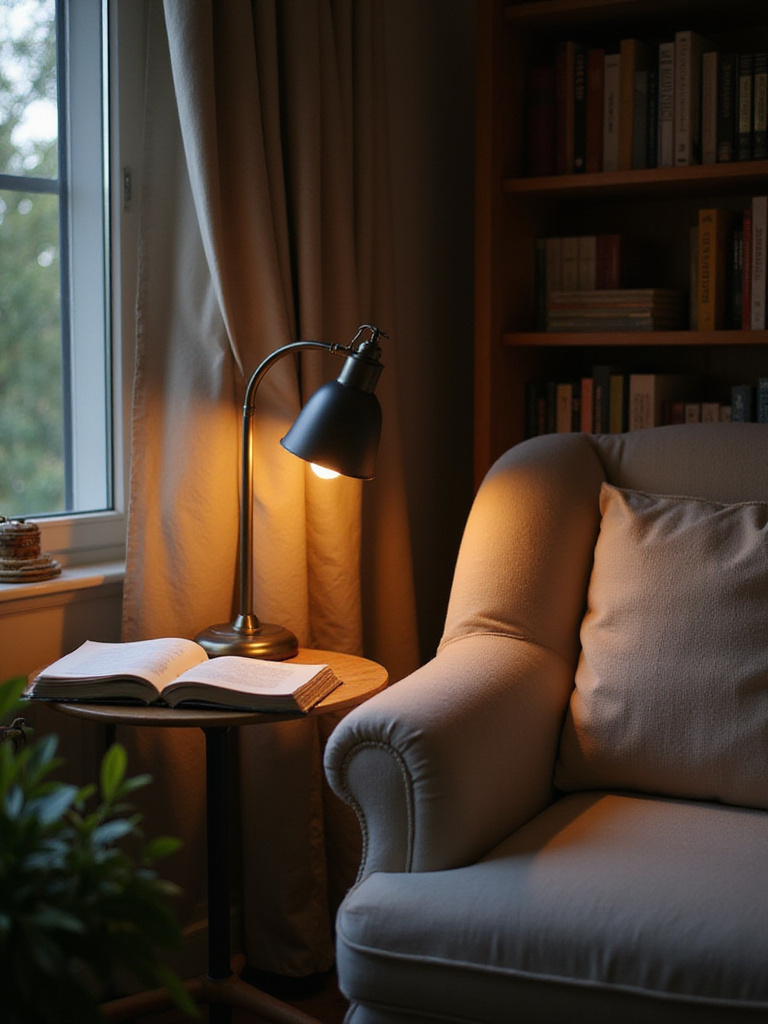
The beauty of table lamps lies in their ability to create human-scale lighting that feels approachable and comfortable. Unlike overhead fixtures that can feel institutional or cold, table lamps provide the kind of warm, intimate illumination that makes people want to settle in and stay. Choose lampshades that complement your color palette while allowing the right amount of light to filter through—too opaque and you lose the cozy glow, too transparent and you create harsh contrasts.
- Swing-arm styles: Provide adjustable task lighting for reading while maintaining style
- Multiple heights: Create visual rhythm by varying lamp heights across different surfaces
- Coordinated but not matching: Choose lamps that share common elements while maintaining individual character
The finishing touch that elevates the entire look involves positioning table lamps at different heights and distances to create layers of light that overlap and interact. This prevents the flat, uniform illumination that can make even the most beautiful rooms feel sterile and unwelcoming.
9. Add Wall Sconces for Sophisticated Ambient Light
Wall sconces bring lighting to the often-overlooked middle zone of your walls, creating sophisticated layers that enhance your living room light design without consuming precious surface space. These fixtures work particularly well in maximalist interiors because they can be integrated with your wall displays—flanking artwork, highlighting architectural details, or providing gentle illumination that makes your gallery walls more dramatic and inviting. Sconces also help create the kind of multi-source lighting that prevents harsh shadows and unflattering contrasts.
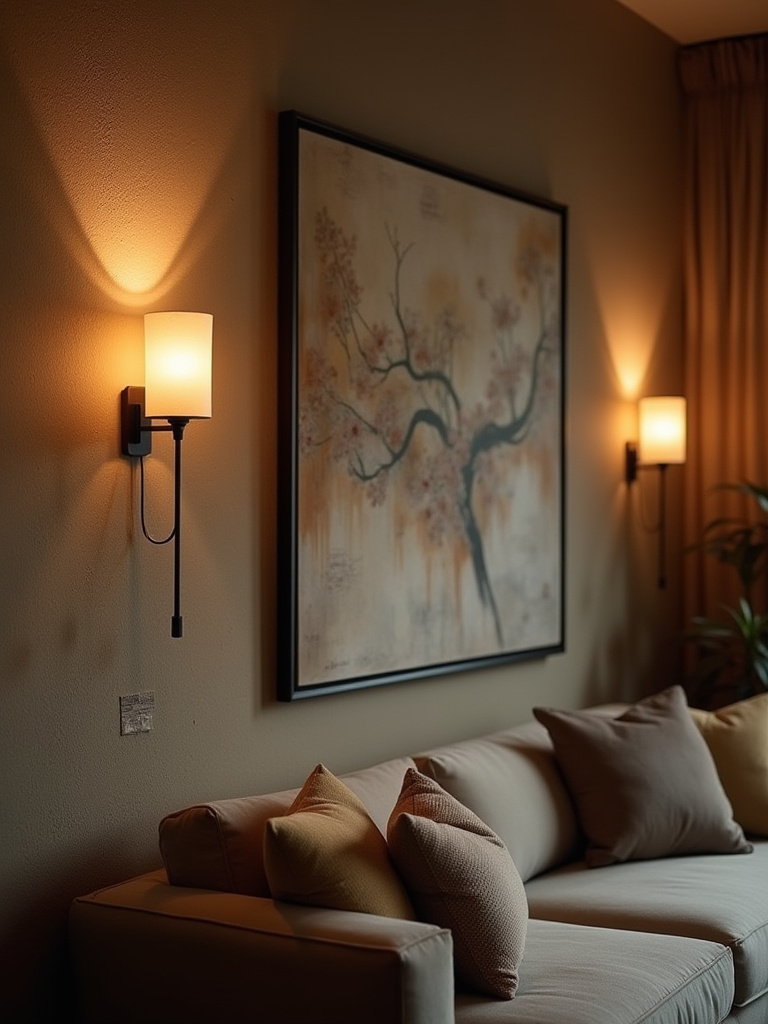
The strategic placement of wall sconces can dramatically alter how your room feels and functions. Use them to create gentle pathways of light along walls lined with bookshelves or collections, or position them to provide reading light beside seating areas without requiring floor or table space for lamps. The key lies in choosing fixtures that complement your aesthetic while providing the right quality of light—whether that’s soft uplighting that makes ceilings feel higher or focused downlighting that highlights specific features.
- Uplighting sconces: Direct light toward ceilings to create spacious, airy feelings
- Adjustable swing-arms: Provide task lighting that can be positioned as needed
- Decorative styles: Choose fixtures that function as wall art when not illuminated
Beyond the obvious placement, consider using sconces to create rhythm and visual interest along longer walls, spacing them to echo the proportions of your furniture or architectural features. This technique helps unify your space while providing practical illumination that enhances both function and beauty.
10. Integrate Recessed Lighting for Clean, Modern Appeal
Recessed lighting offers a sleek solution for your living room light foundation, providing ambient illumination without competing visually with your abundant collections and bold design choices. These fixtures disappear into your ceiling architecture, allowing your carefully curated furnishings and artwork to take center stage while ensuring adequate general illumination throughout the space. The clean lines of recessed lighting work particularly well in maximalist interiors where every surface and wall might be filled with treasured objects.

The versatility of recessed lighting lies in its ability to provide different types of illumination depending on the trim style and beam angle you choose. Wide flood beams create general ambient light, while narrow spots can highlight specific artwork or architectural features. By mixing different beam angles on the same circuit, you create a sophisticated lighting system that serves multiple functions while maintaining the clean aesthetic that lets your collections shine.
- Adjustable trims: Allow you to direct light exactly where needed for highlighting collections
- Wall-washing techniques: Use fixtures positioned close to walls to create even illumination on textured surfaces
- Zoned circuits: Control different areas independently for maximum flexibility
The craftsmanship reveals itself in details like proper spacing and beam overlap—fixtures positioned too far apart create pools of light with dark spaces between, while overcrowding creates a harsh, commercial feeling that undermines the warmth you’ve worked to create in your maximalist haven.
11. Embrace Track Lighting for Ultimate Flexibility
Track lighting systems provide unparalleled adaptability for your living room light design, allowing you to adjust, add, or reposition light sources as your collections grow and change. This flexibility makes track lighting ideal for maximalist spaces where artwork might be rotated, furniture rearranged, or new treasures added regularly. Instead of being locked into fixed positions, track systems let you evolve your lighting along with your ever-changing aesthetic vision.
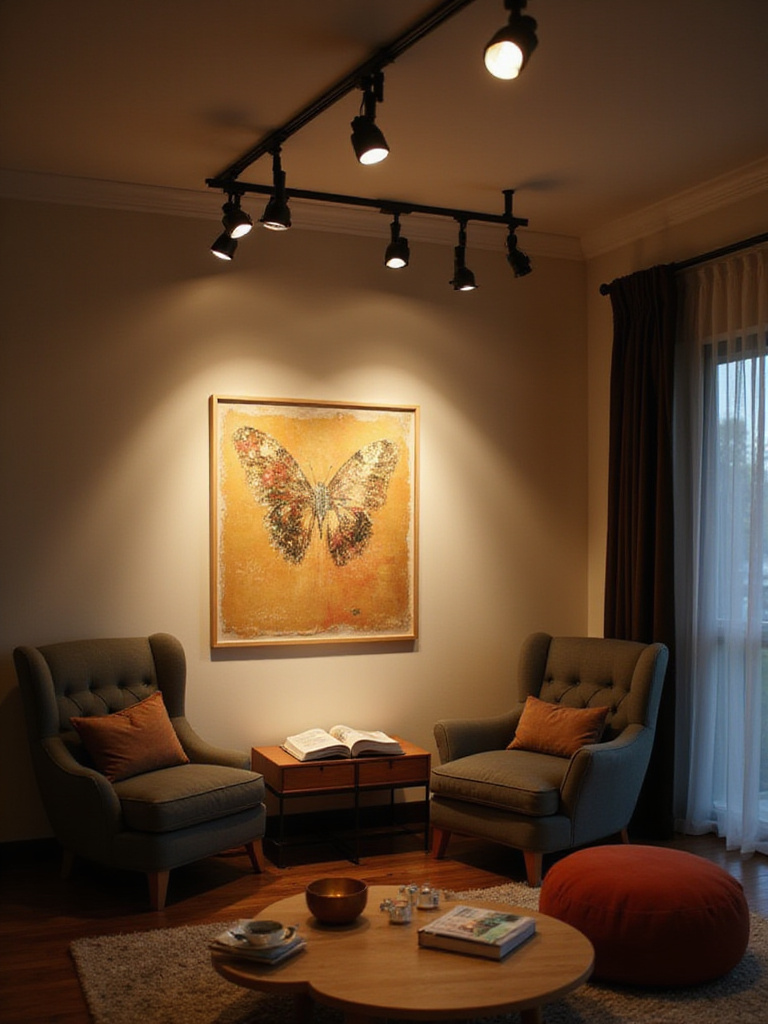
The beauty of track lighting lies in its ability to accommodate different types of light heads on the same system—you can combine narrow spots for highlighting artwork with wider floods for general illumination, or add pendant-style heads for task lighting over specific areas. This versatility means a single track can serve multiple lighting functions while maintaining a cohesive look that doesn’t compete with your room’s visual richness.
- Adjustable spotlights: Perfect for highlighting rotating art collections or seasonal displays
- Mixed beam angles: Combine narrow and wide beams for both accent and ambient lighting
- Expandable systems: Add more heads as your lighting needs grow and change
The design language evolved from traditional patterns when track lighting moved beyond purely functional applications to become a sophisticated design element. Modern track systems offer sleek profiles and high-quality finishes that complement contemporary maximalist aesthetics while providing the technical flexibility to light complex, layered interiors effectively.
12. Highlight Treasured Artwork with Picture Lighting
Your carefully curated art collection deserves lighting that reveals every brushstroke, enhances every color, and creates the kind of gallery-quality illumination that makes your living room light design feel professionally considered. Picture lights provide dedicated illumination that transforms your artwork from wall decoration into commanding focal points that anchor your maximalist aesthetic. These specialized fixtures ensure your treasured pieces receive the attention they deserve while contributing to the overall sophistication of your lighting scheme.
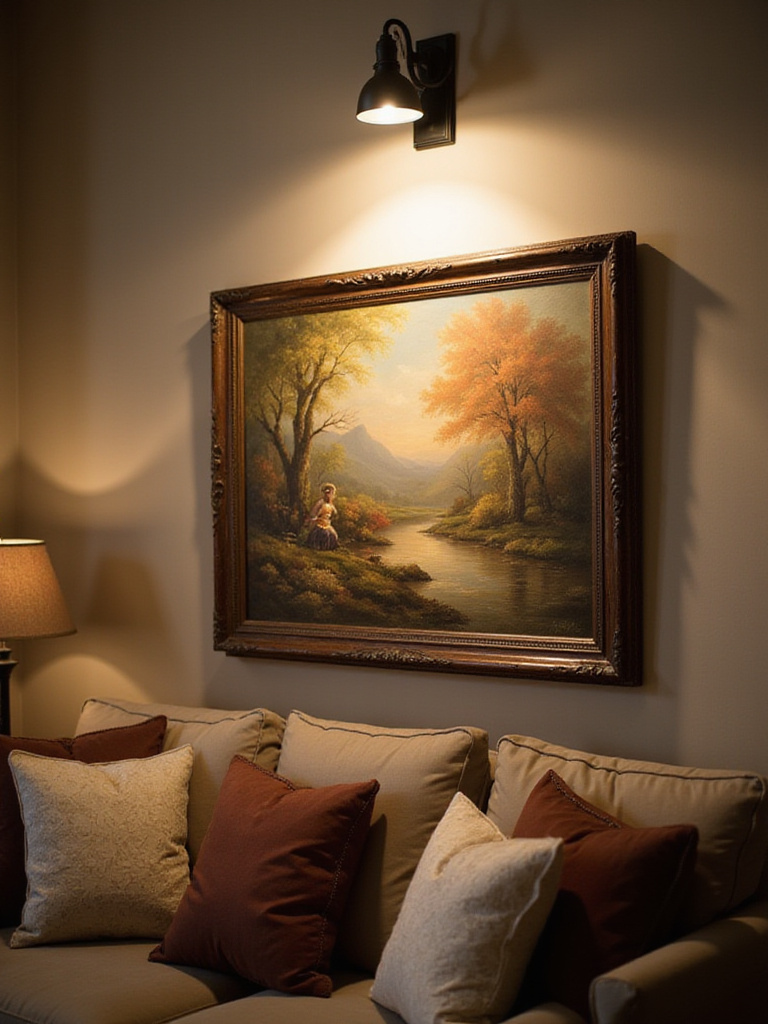
- Proportional sizing: Choose fixtures that span 1/2 to 2/3 the width of each artwork for balanced illumination
- High CRI LEDs: Ensure accurate color rendering that shows your art’s true beauty
- Adjustable positioning: Fine-tune angles to eliminate glare and optimize viewing from different positions
What makes this choice better for our planet is the energy efficiency of modern LED picture lights, which provide superior illumination while using a fraction of the energy of traditional halogen alternatives. This means you can properly light your entire collection without guilt about energy consumption or heat damage to your precious pieces.
13. Create Architectural Drama with Strategic Uplighting
Uplighting techniques transform the structural elements of your room into active participants in your living room light design, highlighting textures, creating dramatic shadows, and emphasizing the architectural bones that support your maximalist aesthetic. This sophisticated approach moves beyond simply illuminating objects to celebrating the very framework of your space—whether that’s exposed beams, textured walls, columns, or built-in features that deserve recognition as design elements in their own right.
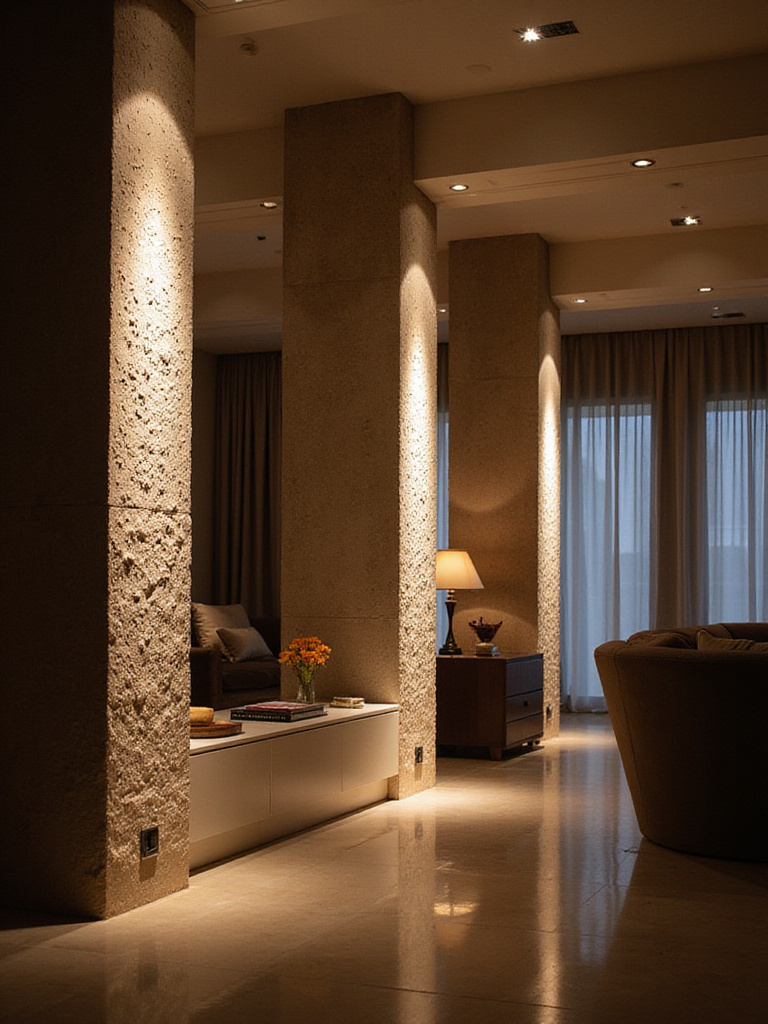
The magic happens when uplighting reveals textures and details that remain invisible under standard ambient lighting. A brick fireplace becomes a dramatic focal point when washed with light from below, while textured plaster walls develop rich patterns of light and shadow that add depth and visual interest. This technique also helps make rooms feel taller and more spacious by drawing the eye upward and emphasizing vertical elements.
- Grazing techniques: Position lights close to textured surfaces to emphasize every detail
- Cove lighting: Hide linear LEDs in architectural details for mysterious, floating effects
- Column highlighting: Use narrow beam uplights to emphasize structural elements
The unexpected environmental benefit comes from uplighting’s efficiency—by bouncing light off ceilings and walls, you often need fewer fixtures and lower wattages to achieve dramatic effects than with direct lighting approaches. This technique maximizes visual impact while minimizing energy consumption, supporting both your aesthetic goals and environmental values.
14. Install Dimmers for Instant Atmosphere Control
Dimmers represent the single most transformative upgrade you can make to your living room light system, providing instant control over mood and atmosphere that adapts your space to any activity or time of day. This simple technology transforms fixed lighting into a dynamic system that can shift from energizing brightness for afternoon activities to intimate warmth for evening gatherings. In maximalist spaces where visual richness can sometimes feel overwhelming, dimmers provide the subtlety needed to create perfect balance.
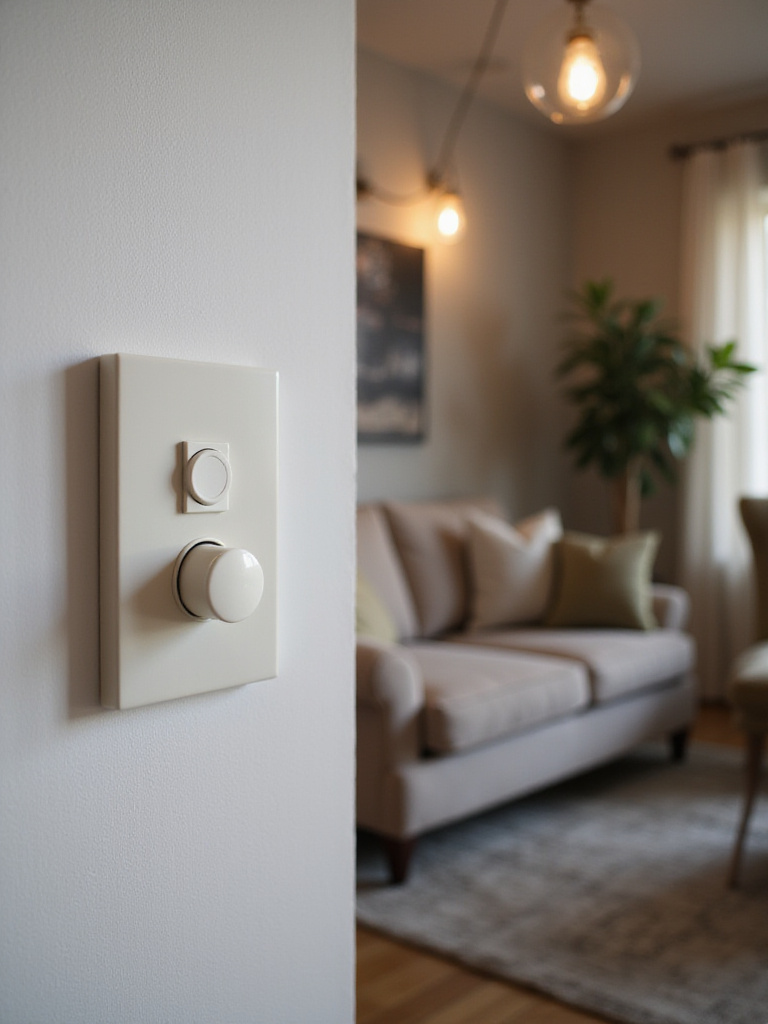
The psychological impact of adjustable lighting cannot be overstated—the ability to fine-tune brightness levels helps create the exact emotional response you want from your space. Bright light energizes and focuses attention on details in your collections, while dimmed lighting creates mystery and intimacy that makes abundant furnishings feel cozy rather than cluttered. This control also extends the usable life of your light bulbs while reducing energy consumption significantly.
- Zone control: Install separate dimmers for ambient, task, and accent lighting circuits
- LED compatibility: Choose dimmers specifically designed for LED bulbs to prevent flickering
- Preset levels: Some advanced dimmers remember your preferred settings for different activities
The mood shifts dramatically when you add smart dimmers that can be controlled remotely or programmed to change automatically throughout the day. Imagine your lighting gradually brightening with the sunrise or automatically dimming as evening approaches, creating seamless transitions that enhance your daily rhythms while showcasing your collections in their best light.
15. Embrace Smart Controls for Effortless Management
Smart lighting technology elevates your living room light control to unprecedented levels of convenience and sophistication, allowing you to manage complex lighting scenes with simple voice commands or smartphone apps. This technology particularly benefits maximalist spaces where multiple light sources need coordination to create the perfect balance between showcasing collections and maintaining comfort. Smart controls transform what could be a complicated system of switches and dimmers into an intuitive, user-friendly experience.
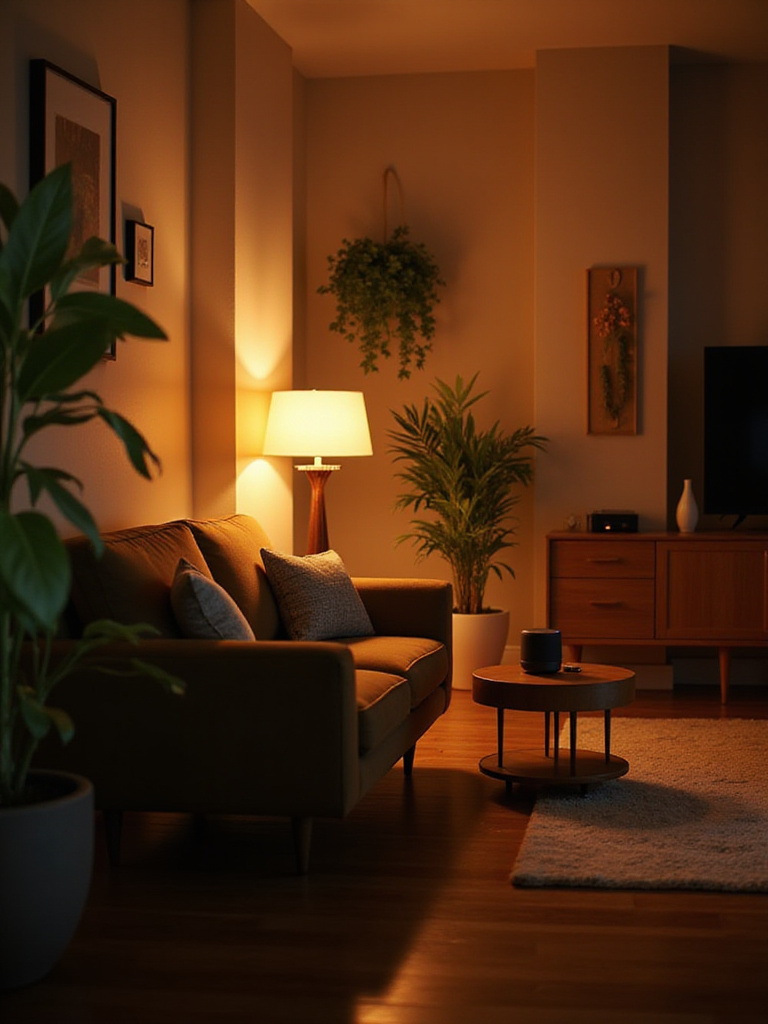
The revolutionary aspect of smart lighting lies in its ability to create and recall custom scenes that coordinate multiple fixtures instantly. Your “Gallery Mode” might highlight artwork while providing gentle ambient light, while “Reading Time” could brighten task lights while dimming decorative fixtures. These preset scenes eliminate the need to manually adjust multiple switches and dimmers, making sophisticated lighting control accessible to everyone in your household.
- Voice activation: Control entire lighting scenes with simple spoken commands
- Smartphone apps: Adjust lights remotely or set schedules for automatic operation
- Scene programming: Create custom combinations that coordinate multiple fixtures perfectly
The sustainable journey of this material involves smart controls’ ability to optimize energy usage automatically—lights can dim when natural light is abundant, turn off when rooms are unoccupied, or adjust color temperature to support natural circadian rhythms. This intelligent automation reduces energy consumption while enhancing the livability of your beautifully lit space.
16. Design Custom Lighting Scenes for Every Mood
Creating personalized lighting scenes transforms your living room light from a basic utility into a sophisticated system that adapts instantly to support any activity or atmosphere you desire. These preset combinations of light levels, fixture selections, and dimming patterns eliminate the complexity of managing multiple light sources manually while ensuring your space always looks and feels exactly right. In maximalist environments where visual balance is crucial, lighting scenes provide the control needed to highlight or soften elements as desired.
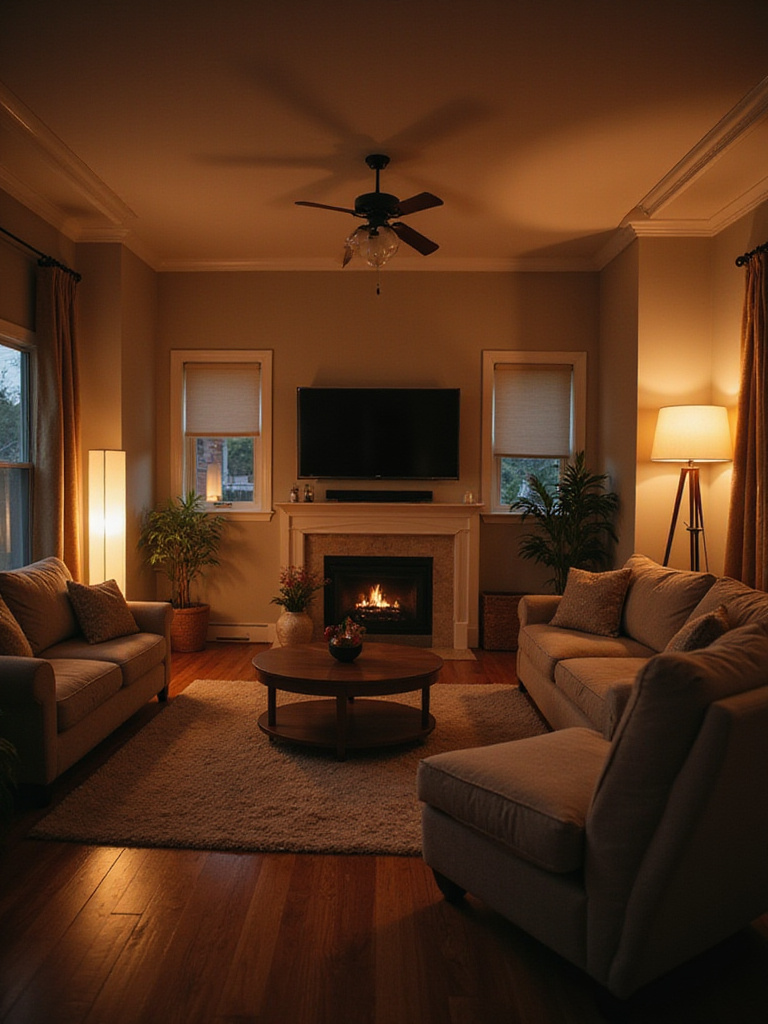
The artistry lies in understanding how different combinations of light create distinct emotional responses and functional environments. Your “Morning Energy” scene might use bright, cool-toned light to energize your space for the day ahead, while “Evening Sophistication” could emphasize warm accent lighting that makes your collections glow mysteriously. Each scene tells a different story about your space while supporting specific activities and moods.
- Activity-based scenes: Create presets for reading, entertaining, relaxing, and working
- Time-of-day programming: Automatically adjust lighting to support natural daily rhythms
- Guest settings: Develop welcoming scenes that showcase your space at its most impressive
The emotional response this evokes begins with the seamless transition between different lighting moods—no more fumbling with multiple switches or settling for compromise lighting that doesn’t quite work. Smart scene control makes your sophisticated lighting system as easy to operate as a single light switch while providing infinitely more possibilities for creating the perfect atmosphere.
17. Master Color Temperature for Perfect Ambiance
Understanding and controlling color temperature gives you sophisticated control over your living room light atmosphere, influencing everything from how colors appear in your collections to how comfortable and inviting your space feels. Measured in Kelvin (K), color temperature ranges from warm, candlelight-like tones (2000K-3000K) to cool, daylight-like illumination (5000K-6500K). Mastering this element allows you to create lighting that enhances your maximalist aesthetic while supporting the activities and moods you want to encourage.
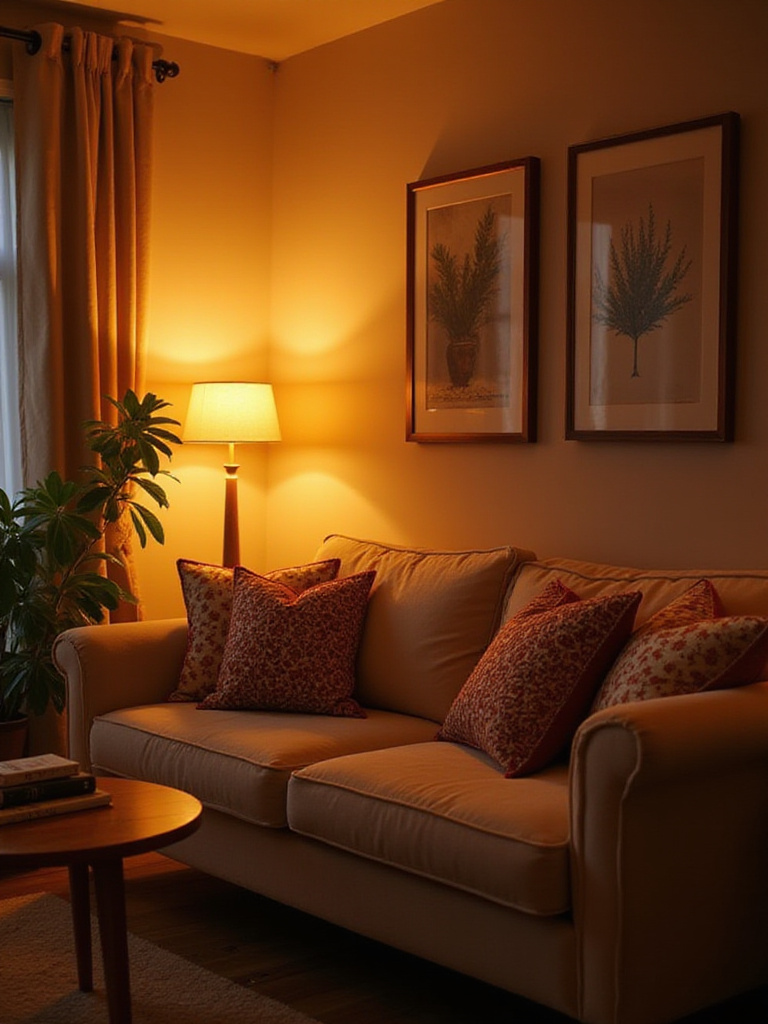
Warm color temperatures (2700K-3000K) enhance the cozy, collected feeling that makes maximalist spaces so inviting, bringing out rich tones in wood furniture, warm metals, and jewel-toned textiles. These temperatures also promote relaxation and make people feel more comfortable in abundant, richly furnished environments. Cooler temperatures work better for task lighting where color accuracy and alertness are important, such as reading areas or spaces where you examine details in your collections.
- Warm ambient lighting: Use 2700K-3000K for general room illumination that feels welcoming
- Neutral task lighting: Choose 3000K-3500K for reading and detail work that requires clarity
- Tunable options: Consider smart bulbs that adjust color temperature throughout the day
The heritage technique gets a contemporary update through tunable white technology, which allows you to adjust color temperature dynamically rather than being locked into a single choice. This flexibility means your lighting can support energizing morning routines with cooler light, then transition to warm, relaxing tones for evening activities.
18. Understand Lumens for Proper Brightness Planning
Moving beyond the outdated practice of shopping for light bulbs by wattage, understanding lumens empowers you to create precisely the right brightness levels for every aspect of your living room light design. Lumens measure actual light output rather than energy consumption, allowing you to achieve optimal illumination while maximizing energy efficiency. This knowledge becomes particularly important in maximalist spaces where you need adequate light to appreciate collections and details without creating harsh, unflattering conditions.

Different activities and areas within your living room require specific lumen levels for optimal comfort and function. General ambient lighting typically needs 20-30 lumens per square foot, while task areas like reading nooks require 50-100 lumens per square foot. Accent lighting for highlighting artwork or collections might use focused beams of 200-500 lumens depending on the size and importance of the featured objects.
- Ambient lighting: Plan for 1,500-3,000 lumens total for a typical living room
- Task lighting: Provide 800-1,200 lumens for comfortable reading and detail work
- Accent lighting: Use 200-800 lumens to highlight specific features without overwhelming
The quality becomes evident after years of use when proper lumen planning prevents eye strain and creates consistently comfortable lighting conditions. By understanding exactly how much light you need for each function, you can select fixtures and bulbs that provide optimal illumination without waste or inadequacy.
19. Invest in Energy-Efficient LED Technology
LED technology represents the most significant advancement in living room light efficiency and quality in decades, offering dramatic energy savings, exceptional longevity, and superior light quality that enhances your maximalist aesthetic. Modern LEDs use up to 85% less energy than traditional incandescent bulbs while lasting 15-25 times longer, making them both environmentally responsible and economically smart choices for your sophisticated lighting system.
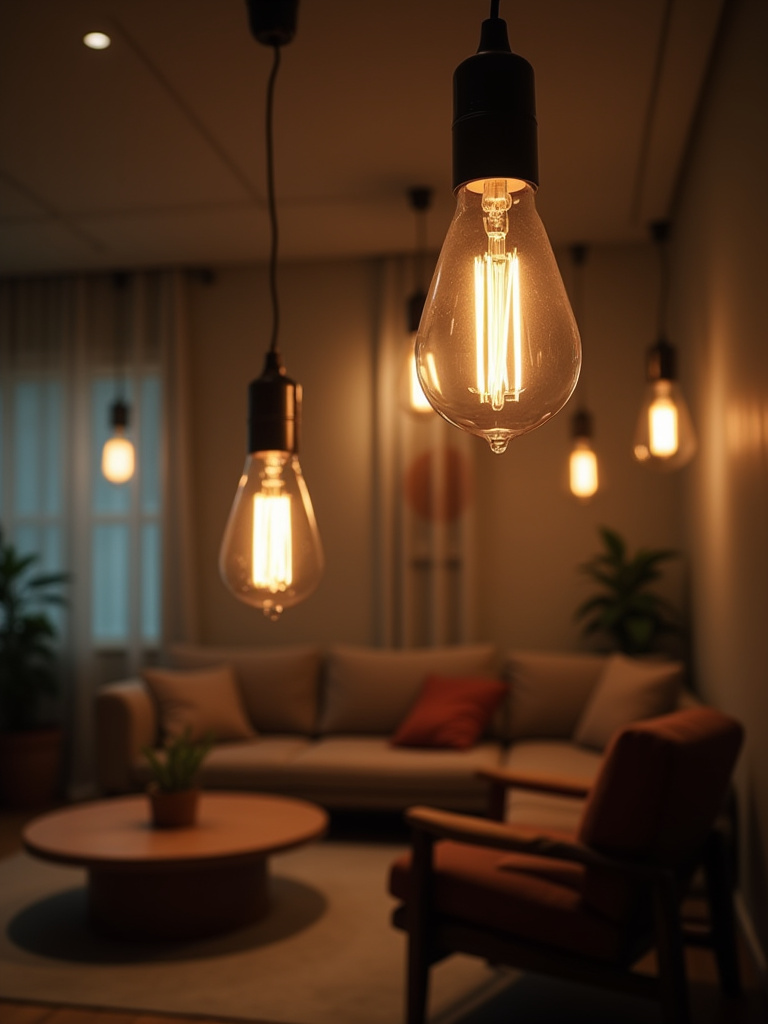
Beyond energy savings, LEDs offer technical advantages that particularly benefit complex lighting designs. They produce minimal heat, allowing you to use them in enclosed fixtures and near heat-sensitive artwork without concern. Their instant-on capability means no waiting for lights to warm up, while their excellent dimming performance provides smooth control from bright task lighting to barely perceptible accent illumination.
- Dramatic energy savings: Reduce lighting electricity costs by 75-85% compared to incandescent bulbs
- Extended lifespan: Enjoy 15,000-50,000 hours of operation before replacement needed
- Superior color quality: High CRI options reveal true colors in artwork and collections
The investment value comes from the exceptional durability and performance that eliminates the frequent bulb changes and energy waste associated with older technologies. Quality LED bulbs may cost more initially, but their combination of energy savings and longevity typically pays for itself within the first year of use while providing superior light quality throughout their extended lifespan.
20. Plan Electrical Requirements Before Shopping
Strategic electrical planning forms the foundation of any successful living room light design, ensuring your vision can be implemented safely and aesthetically without unsightly extension cords or compromised fixture placement. This crucial step involves assessing your current electrical capacity, identifying where new circuits or outlets might be needed, and understanding the power requirements of your planned lighting system before making any fixture purchases.
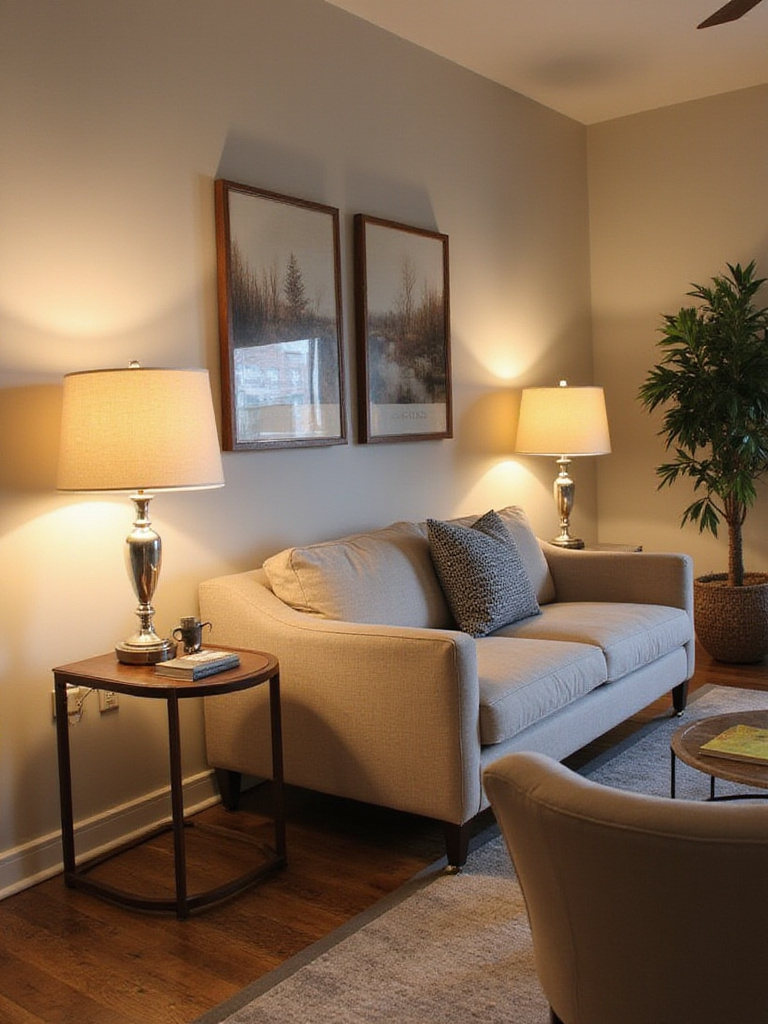
Modern lighting systems, particularly those incorporating smart controls and multiple LED fixtures, have different electrical requirements than traditional setups. While LEDs use less power individually, comprehensive lighting designs often involve more fixtures, and smart controls may require neutral wires that aren’t present in older homes. Understanding these requirements early prevents costly surprises and ensures your sophisticated lighting plan can be implemented as designed.
- Circuit capacity: Ensure existing circuits can handle additional lighting loads safely
- Smart control requirements: Verify neutral wire availability for advanced dimming systems
- New outlet planning: Identify locations where additional power access would improve flexibility
The traditional methods used result in proper electrical infrastructure that supports both current needs and future expansion. Professional electrical assessment early in the planning process ensures your lighting design can be implemented safely and efficiently while meeting all local codes and safety requirements.
21. Balance Natural and Artificial Light Sources
The most sophisticated living room light designs seamlessly integrate natural daylight with artificial illumination, creating dynamic environments that adapt beautifully throughout the day while maintaining consistent comfort and visual appeal. This holistic approach maximizes the benefits of both light sources—using abundant daylight when available while ensuring artificial lighting provides smooth transitions as natural light fades. The result is a space that feels alive and responsive to natural rhythms while maintaining perfect illumination for your collections and activities.
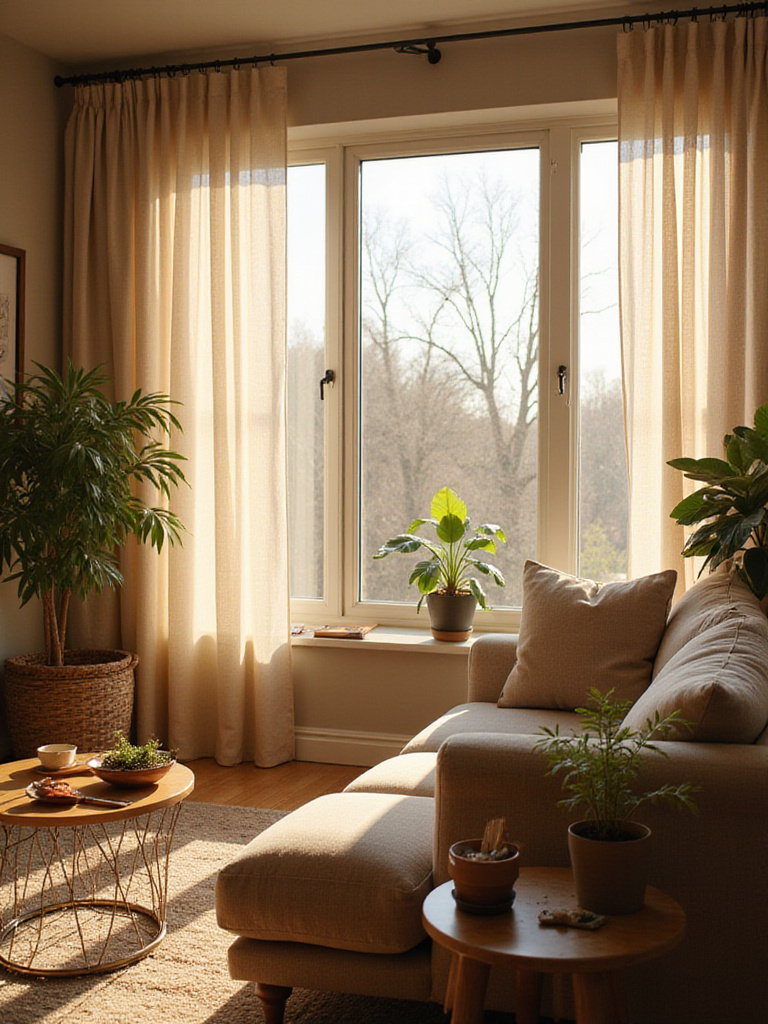
Understanding how natural light changes throughout the day allows you to position artificial fixtures strategically to complement rather than compete with daylight. Morning light might flood certain seating areas, making task lighting unnecessary until afternoon, while evening requires careful artificial lighting to maintain the warmth and intimacy that makes maximalist spaces so inviting. Window treatments play a crucial role in controlling natural light quality and preventing glare that could wash out your carefully planned artificial lighting.
- Daylight assessment: Map how natural light moves through your space throughout the day
- Complementary positioning: Place artificial fixtures to fill shadows and extend daylight benefits
- Glare control: Use window treatments to manage harsh sunlight that could overpower artificial lighting
The evolution of this trend reflects broader cultural shifts toward wellness and sustainability—spaces that work with natural light patterns support circadian rhythms while reducing energy consumption. Smart lighting systems can even adjust automatically based on available daylight, maintaining consistent illumination levels while maximizing energy efficiency.
22. Create a Comprehensive Budget for Your Lighting Project
Developing a realistic budget ensures your living room light transformation can be completed successfully without financial stress or compromised quality. A comprehensive budget accounts for all project elements—fixtures, bulbs, controls, installation labor, and potential electrical upgrades—while including contingency funds for unexpected discoveries or desired improvements. This planning prevents the disappointment of having to scale back your vision due to unforeseen costs.

Professional installation often represents 40-60% of total project costs, particularly for hardwired fixtures, new circuits, or smart control systems that require specialized knowledge. Quality fixtures and advanced controls represent investments that provide years of superior performance and energy savings, making them worthwhile even when initial costs seem significant. Understanding these proportions helps you allocate funds effectively while ensuring professional results.
- Fixture costs: Research prices for desired styles and quality levels across all lighting types
- Installation expenses: Obtain quotes from qualified electricians for hardwired and smart system work
- Control systems: Budget for dimmers, smart switches, and any required hubs or controllers
- Contingency planning: Reserve 15-20% additional for unexpected issues or desired upgrades
The maker’s journey from apprentice to master influenced this understanding—lighting design requires both artistic vision and technical expertise to achieve truly exceptional results. Investing in quality components and professional installation ensures your sophisticated lighting system will provide years of reliable performance while enhancing the beauty and functionality of your maximalist haven.
Conclusion
Mastering your living room light transforms more than just visibility—it elevates your entire space into a dynamic environment that celebrates your collections, supports your lifestyle, and adapts effortlessly to every mood and activity. By layering ambient, task, and accent lighting thoughtfully, incorporating smart controls for ultimate flexibility, and choosing quality LED technology for efficiency and longevity, you create a lighting system as sophisticated and personal as your maximalist aesthetic.
The journey from basic illumination to masterful lighting design requires understanding both technical elements and artistic principles. From assessing your space’s unique needs to budgeting for professional installation, each step builds toward a comprehensive system that makes your treasured collections shine while providing the comfort and functionality that makes your living room truly livable. The investment in quality fixtures, smart controls, and proper planning pays dividends in daily enjoyment, energy savings, and the enhanced beauty of your carefully curated space.
Don’t settle for lighting that merely illuminates when you could have illumination that inspires. Start with one layer—perhaps adding task lighting to your favorite reading spot or installing dimmers for instant mood control—then build your system gradually as budget and enthusiasm allow. Your living room deserves lighting as bold and thoughtful as the design choices that make it uniquely yours.
